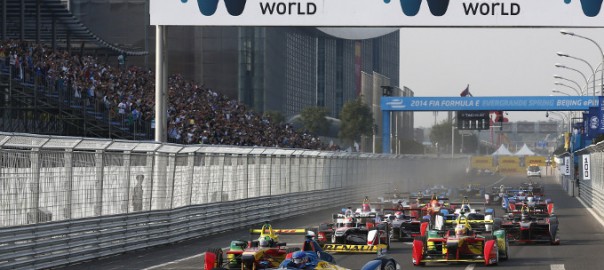With only three days until Round-2 of the inaugural FIA Formula-E Championship is upon us, I thought it was time to take a deeper look into this interesting racing series.
The debut of Formula-e racing was held in the streets of Beijing on 13th September 2014. You can read my review of that here. There was great racing from quality drivers with interesting incidents. That’s what you would expect from any racing series so what makes Forumla-e different?
Firstly, the obvious part is the “e” – this is the first fully electric single-seater racing series. The car is the Spark-Renault SRT_01E which uses a Dallara chassis, a McLaren engineered electric motor, a Rechargeable Energy Storage System (RESS) part of which has been engineered by Williams and it rides on Michelin tyres. This being a racing series that champions sustainability and cost saving, the tyre is essentially a road tyre, capable of running in both wet and dry conditions. One set of tyres should last a whole race weekend.
The “electric” part presents a number of issues for ensuring entertaining racing. The sound is an immediate problem, especially in the aftermath of the controversy over Formula 1 went through when the engines were downgraded for eight to six cylinders. The new sound of F1 is more tame than it ever has been and this has led to criticism from pundits and the race going public. So much so that some different artificial sound enhancing tricks have been tried to no avail. This however has meant that the problem of very little sound coming from an electrical power unit being much less of an issue. In practice, the Formula-e car sounds just as aggressive as the current Formula 1 engine, just a little less loud.
Another big problem with an electric car is refuelling. Currently there is very little in the way of technology that allows a car to be recharged in the time it takes for a pit stop to happen. How do Formula-e get around this? Simple, have two cars. Instead of pulling in to change tyres or recharge the battery, the driver simple hops out of one car and into another. Now this works at the moment but it isn’t exactly the most economical way of running proceedings. It means that each team, of which there are ten, has to have four cars as a minimum, two for each driver. Not ideal, however this can only be positive for the future of electric cars. With Formula-e investing time and money improving the image of the sport and electric cars in general, they will surely have to look at a way of improving this set up. Maybe a 3.5-second way of changing the batteries or a 10-second way of charging. All potential exciting developments for the future of road cars.
So, there are some issues but all of them so far, have been easy to account for. Here comes one part of Formula-e that I just can’t get past, “Fan Boost”. Three drivers out of the twenty in the field, are given a 5-second “Fan Boost”. This is measured purely on popularity via social media. This will force drivers to work harder in the media, gain more “Followers” and ask them to vote for them. I am not sure that measuring how popular you are to the public, should have any bearing on anything in your life, let alone the outcome of an otherwise very equal race. This boost, though it seems relatively ineffective, with a 5-second boost equivalent to 40 BHP for the drivers to use twice in the race (once in each car) feels like a poor gimmick taken from 1980’s Saturday morning kids television that Formula-e would do well to be rid of.
Another problem for me is the length of time between races. I understand that the logistics of getting a city ready to host a race are extremely complicated. Unfortunately, Formula-e whet the appetite for this series with an incident packed race-one in mid-September but race-two will not take place until the end of November, easily enough time for the public to forget it. Thankfully the rest of the races will be closer together but still 3 weeks to a month apart, the schedule is below.
Problems aside, the first race was gripping and I am genuinely excited about the close fought racing that is likely to await us in this year’s Formula E championship. I am also eager to see how this innovative series can improve both itself and race cars of the future. It also forces the likes of Formula 1 to ensure they are genuinely at the forefront of fuel-efficient racing and encourages new efficiencies through both series’, into our road cars.
The next race will be broadcast live on ITV4 at 6am on Saturday 22nd November.
Race Schedule
Round 1 – 13 Sept 2014 – Beijing, China
Round 2 – 22 Nov 2014 – Putrajaya, Malaysia
Round 3 – 13 Dec 2014 – Punta del Este, Uruguay
Round 4 – 10 Jan 2015 – Buenos Aires, Argentina
Round 5 – 14 Feb 2015 – TBA*
Round 6 – 14 Mar 2015 – Miami, USA
Round 7 – 4 Apr 2015 – Long Beach, USA
Round 8 – 9 May 2015 – Monte Carlo, Monaco
Round 9 – 30 May 2015 – Berlin, Germany
Round 10 – 27 Jun 2015 – London, United Kingdom
* Rio de Janeiro was originally scheduled to host a race in November but the calendar has since changed and though the date has been selected for Round 5, no venue has been announced.
